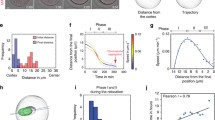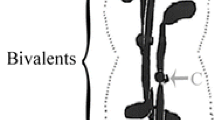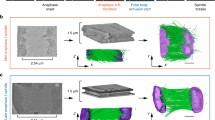Summary
We investigated the possible involvement of actin in the attachment of chromosomes to spindles in crane-fly primary spermatocytes. In a previous study, cytochalasin D, an inhibitor of actin polymerisation, prevented bivalent attachment to microtubules when applied at prophase, but did not cause the detachment of already attached bivalents. We were able to detach the already attached bivalents by first treating prometaphase cells with an antitubulin drug, nocodazole, to disrupt spindle microtubules. 2 min after nocodazole addition, we added cytochalasin D, to disrupt actin filaments; then 2 min later nocodazole was removed, and the cells were kept in cytochalasin D until the time of normal anaphase. Double treatment with nocodazole and cytochalasin D blocked reattachment of bivalents to the spindle. Single treatment with nocodazole alone caused chromosome detachment but did not prevent reattachment when nocodazole was washed out. Extended treatment with cytochalasin D alone starting in prometaphase did not cause bivalents to detach from the spindle. These data suggest that actin is needed for attachment of bivalents to spindle microtubules. This protocol is relevant to the anaphase-onset checkpoint. From previous experiments it was argued that the anaphase-onset checkpoint recognises unattached chromosomes only after those chromosomes first interact with (become attached to) the spindle. Our experiments showed that anaphase disjunction occurred at normal times when bivalents were prevented from attaching to the spindle (by adding cytochalasin D in prophase), while anaphase disjunction was greatly delayed when previously attached bivalents were detached (with nocodazole) and then prevented from re-attaching (with cytochalasin D) in the double treated cells. Thus the anaphaseonset checkpoint recognises only those unattached bivalents that previously were attached to the spindle. Other results provided further indication that actin-microtubule interactions are important in spindle organisation. Nocodazole treatment for 4 min caused most microtubules to disappear: bivalents aggregated around remnant microtubules. When cytochalasin D treatment followed nocodazole treatment, remnant spindle microtubules were not seen, suggesting that actin interactions help stabilise those microtubules.
Similar content being viewed by others
Abbreviations
- CD:
-
cytochalasin D
- NMBD:
-
nuclear-membrane breakdown
- NOC:
-
nocodazole
References
Alexander SP, Rieder CL (1991) Chromosome motion during attachment to the vertebrate spindle: initial saltatory-like behavior of chromosomes and quantitative analysis of force production by nascent kinetochore fibers. J Cell Biol 113: 805–815
Bednara J, Willemse MTM, Van Lammeren AAM (1990) Organization of the actin cytoskeleton during megasporogenesis inGasteria erucosa visualized with fluorescent-labelled phalloidin. Acta Bot Neerl 39: 43–48
Brown KD, Wood KW, Cleveland DW (1996) The kinesin-like protein CENP-E is kinetochore-associated throughout poleward chromosome segregation during anaphase-A. J Cell Sci 109: 961–969.
Brown S, Spudich J (1979) Cytochalasin inhibits the rate of elongation of actin filament fragments. J Cell Biol 83: 657–662
Cleary AL (1995) F-actin redistributions at the division site in livingTradescantia stomatal complexes as revealed by microinjection of rhodamine-phalloidin. Protoplasma 185: 152–165
Cooper J (1987) Effects of cytochalasin and phalloidin on actin. J Cell Biol 105: 1473–1478
Correas I, Padilla R, Avila J (1990) The tubulin-binding sequence of brain microtubule-associated proteins, tau and MAP-2, is also involved in actin binding. Biochem J 269: 61–64
Czaban BB, Forer A (1992) Rhodamine labelled phalloidin stains components in the chromosomal spindle fibres of crane-fly spermatocytes andHaemanthus endosperm cells. Biochem Cell Biol 70: 664–676
— — (1994) Rhodamine-phalloidin and anti-tubulin antibody staining of spindle fibres that were irradiated with an ultraviolet microbeam. Protoplasma 178: 18–27
Dietz R (1956) Die Spermatocytenteilungen der Tipuliden, II. Mitteilung: Graphische Analyse der Chromosomenbewegung während der Prometaphase I im Leben. Chromosoma 8: 183–211
Dinis AM, Mesquita JF (1993) The F-actin distribution during microsporogenesis inMagnolia soulangeana Soul. (Magnoliaceae). Sex Plant Reprod 6: 57–63
Echeverri C, Paschal K, Vaughan K, Vallee R (1996) Molecular characterization of the 50 kD subunit of dynactin reveals function for the complex in chromosome alignment and spindle organization during mitosis. J Cell Biol 132: 617–633
Fach BL, Graham SF, Keates RAB (1985) Association of fodrin with brain microtubules. Can J Biochem Cell Biol 63: 372–381
Ferhat L, Represa A, Bernard A, Ben-Ari Y, Khrestchatisky M (1996) MAP2d promotes bundling and stabilization of both microtubules and microfilaments. J Cell Sci 109: 1095–1103
Forer A, Behnke O (1972) An actin-like component in spermatocytes of a crane-fly (Nephrotoma suturalis Loew) I: the spindle. Chromosoma 39: 145–173
Forer A, Pickett-Heaps JD (1998a) Cytochalasin D and latrunculin affect chromosome behaviour during meiosis in crane-fly spermatocytes. Chromosome Res 6: 533–549
— — (1998b) Checkpoint control in crane-fly spermatocytes: unattached chromosomes induced by cytochalasin D or latrunculin treatment do not prevent or delay the start of anaphase. Protoplasma 203: 100–111
—, Jackson WT, Engberg A (1979) Actin in spindles ofHaemanthus katherinae endosperm II: distribution of actin in chromosomal spindle fibres, determined by analysis of serial sections. J Cell Sci 37: 349–371
Fujii T, Watanabe M, Ogoma Y, Kondo Y, Aray T (1993) Microtubule associated proteins MAP1A and MAP1B interact with F-actin in vitro. J Biochem 114: 827–829
Gawadi N (1974) Characterization and distribution of microfilaments in dividing locust testis cells. Cytobios 10: 17–35
Hasezawa S, Sano T, Nagata T (1998) The role of microfilaments in the organization and orientation of microtubules during the cell cycle transition from M phase to g1 phase in tobacco BY-2 cells. Protoplasma 202: 105–114
Hayden JH, Bowser SS, Rieder CL (1990) Kinetochores capture astral microtubules during chromosome attachment to the mitotic spindle: direct visualisation in live newt lung cells. J Cell Biol 111: 1039–1045
Hoebecke J, Van Nijen G, De Brabander M (1976) Interactions of nocodazole (R17934), a new anti-tumoral drug, with rat brain tubulin. Biochem Biophys Res Commun 69: 319–324
Holleran EA, Tokito MK, Karki S, Holzbaur LF (1996) Centractin (ARP1) associates with spectrin revealing a potential mechanism to link dynactin to intracellular organelles. J Cell Biol 135: 1815–1829
Kengen H, Eygensteyn J, Van Aster T (1995) F-actin in mitotic spindles of synchronised suspension culture cells of tobacco visualised by confocal laser scanning microscopy. Cell Biol Int 7: 585–592
Krendel M, Sgourdas G, Bonder E (1998) Dissasembly of actin filaments leads to increased rate and frequency of mitochondrial movement along microtubules. Cell Motil Cytoskeleton 40: 368–387
La Fountain JR Jr (1971) Spindle volume estimates during crane-fly meiosis. Exp Cell Res 69: 460–462
— (1972) Spindle shape changes as an indicator of force production in crane-fly spermatocytes. J Cell Sci 10: 79–93
—, Janicke MA, Balczon R, Rickards GK (1992) Cytochalasin induces abnormal anaphase in crane-fly spermatocytes and causes altered distribution of actin and centromeric antigens. Chromosoma 101: 425–441
—, Siegel AJ, Rickards GK (1999) Chromosome movement during meiotic prophase in crane-fly spermatocytes IV: actin and the effects of cytochalasin D. Cell Motil Cytoskeleton 43: 199–212
LeMaire R, Radke K, Hunt P (1997) Lack of checkpoint control at the metaphase/anaphase transition: a mechanism of meiotic nondisjunction in mammalian females. J Cell Biol 139: 1611–1619
Li X, Nicklas B (1997) Tension-sensitive kinetochore phosphorylation and the chromosome distribution checkpoint in praying mantid spermatocytes. J Cell Sci 110: 537–545
Merdes A, De Mey J (1990) The mechanism of kinetochore-spindle attachment and polewards movement analysed in PtK2 cells at the prophase-prometaphase transition. Eur J Cell Biol 53: 313–325
Nicklas BR, Ward SC (1994) Elements of error correction in mitosis: microtubule capture, release, and tension. J Cell Biol 5: 1241–1253
Pfarr CM, Coe M, Grissom PM, Hays TS, Porter ME, McIntosh JR (1990) Cytoplasmic dynein is localised to kinetochores during mitosis. Nature 345: 263–265
Pickett-Heaps JD, Spurck T (1982) Studies on kinetochore function in mitosis I: effects of colchicine and cytochalasin on mitosis in the diatomHantzschia amphioxys. Eur J Cell Biol 28: 77–82
—, Forer A, Spurck T (1996) Rethinking anaphase: where “Pac-Man” fails and why a role for the spindle matrix is likely. Protoplasma 192: 1–10
Rieder CL, Alexander SP (1990) Kinetochores are transported poleward along a single astral microtubule during chromosome attachment to the spindle in newt lung cells. J Cell Biol 110: 81–95
Sampson K, Pickett-Heaps JD, Forer A (1996) Cytochalasin D blocks chromosomal attachment to the spindle in the green algaOedogonium. Protoplasma 192: 130–144
Sanger JW (1975) Presence of actin during chromosomal movement. Proc Natl Acad Sci USA 72: 2451–2455
Schaar BT, Chan GMT, Maddox P, Salmon ED, Yen TJ (1997) CENP-E function at kinetochores is essential for chromosome alignment. J Cell Biol 6: 1373–1382
Schafer D, Gill S, Cooper J, Henser J, Schroer T (1994) Ultrastructural analysis of the dynactin complex: an actin-related protein is a component of a filament that resembles F-actin. J Cell Biol 126: 403–412
Schmit AC, Lambert AM (1990) Microinjected fluorescent phalloidin in vivo reveals the F-actin dynamics and assembly in higher plant mitotic cells. Plant Cell 2: 129–138
Seagul RW, Falconer MM, Werdenburg CA (1987) Microfilaments: dynamic arrays in higher plant cells. J Cell Biol 104: 995–1004
Sider JN, Mandato CA, Weber KL, Zandy AJ, Beach D, Finst RJ, Skoble J, Bernent WM (1999) Direct observation of microtubulef-actin interaction in cell free lysates. J Cell Sci 112: 1947–1956
Silverman-Gavrila RV, Forer A (2000) Evidence that actin and myosin are involved in the poleward flux of tubulin in metaphase kinetochore microtubules of crane-fly spermatocytes. J Cell Sci 113: 597–609
Snyder J, Cohen L (1995) Cytochalasin J affects chromosome congression and spindle microtubule organization in PtK1 cells. Cell Motil Cytoskeleton 32: 245–257
Spector I, Shochet M, Blasberger D, Kushman I (1989) Latrunculins, novel marine macrolides that disrupt microfilament organization and affect cell growth I: comparison with cytochalasin D. Cell Motil Cytoskeleton 13: 127–144
Spurck TP, Pickett-Heaps JD, Klymkowsky MW (1986) Metabolic inhibitors and mitosis II: effects of dinitrophenol/deoxyglucose and nocodazole on the microtubule Cytoskeleton. Protoplasma 131: 60–74
Staiger CJ, Cande ZW (1991) Microfilament distribution in maize meiotic mutants correlates with microtubule organization. Plant Cell 3: 637–644
Steuer ER, Wordeman L, Schroer TA, Schutz MP (1990) Localization of cytoplasmic dynein to mitotic spindles and kinetochores. Nature 345: 266–268
Thrower DA, Jordan MA, Wilson L (1996) Modulation of CENP-E organization at kinetochores by spindle microtubule attachment. Cell Motil Cytoskeleton 35: 121–133
Tögel M, Wiche G, Propst F (1998) Novel features of the light chain of microtubule associated protein MAP1B: microtubule stabilization, self interaction, actin filament binding, and regulation by the heavy chain. J Cell Biol 143: 695–707
Traas JA, Doonan JH, Rawlins DJ, Shaw PJ, Watts J, Lloyd CW (1987) An actin network is present in the cytoplasm throughout the cell cycle of carrot cells and associates with the dividing nucleus. J Cell Biol 105: 387–395
—, Burgain S, Dumas de Vaulx H (1989) The organization of the Cytoskeleton during meiosis in eggplant (Solanum melongena (L.)): microtubules and F-actin are both necessary for coordinated meiotic division. J Cell Sci 92: 541–550
Urbanik E, Ware B (1989) Actin filament capping and cleaving activity of cytochalasins B, D, E and H. Arch Biochem Biophys 269: 181–187
Van Lammeren AAM. Bednara J, Willemse MTM (1989) Organization of the actin cytoskeleton during pollen development inGasteria errucosa (Mill) H. Duval visualized with rhodaminephalloidin. Planta 178: 531–539
Vasquez RJ, Hovell B, Yvon A-M, Wadsworth P, Cassimeris L (1997) Nanomolar concentrations of nocodazole alter microtubule dynamic instability. Mol Biol Cell 8: 973–985
Waterman-Storer CM, Salmon ED (1997) Actomyosin-based retrograde flow of microtubules in the lamella of migrating epithelial cells influences microtubule dynamic instability and turnover and is associated with microtubule breakage and treadmilling. J Cell Biol 139: 417–434
—, Karki S, Holzbaur E (1995) The pl50Glued component of the dynactin complex binds to both microtubules and the actin related protein centractin (Arp-1). Proc Natl Acad Sci USA 92: 1634–1638
Waters JC, Chen R-H, Murray AW, Salmon ED (1998) Localization of Mad2 to kinetochores depends on microtubule attachment, not tension. J Cell Biol 141: 1181–1191
Wilson PJ, Forer A (1989) The behaviour of microtubules in chromosomal spindle fibres irradiated singly or doubly with ultraviolet light. J Cell Sci 94: 265–634
— —, Leggiardo C (1994) Evidence that kinetochore microtubules in crane-fly spermatocytes disassemble during anaphase primarily at the poleward end. J Cell Sci 107: 3015–3027
Wood KW, Sakowicz R, Goldstein LSB, Cleveland DW (1997) CENP-E is a plus end-directed kinetochore motor required for metaphase chromosome alignment. Cell 91: 357–366
Wrench J, Snyder J (1997) Cytochalasin J treatment significantly alters mitotic spindle microtubule organization and kinetochore structure in PtK1 cells. Cell Motil Cytoskeleton 36: 112–124
Yao X, Anderson KL, Cleveland DW (1997) The microtubule-dependent motor centromere-associated protein E (CENP-E) is an integral component of kinetochore corona fibers that link centromeres to spindle microtubules. J Cell Biol 2: 435–447
Author information
Authors and Affiliations
Rights and permissions
About this article
Cite this article
Silverman-Gavrila, R.V., Forer, A. Chromosome attachment to the spindle in crane-fly spermatocytes requires actin and is necessary to initiate the anaphase-onset checkpoint. Protoplasma 212, 56–71 (2000). https://doi.org/10.1007/BF01279347
Received:
Accepted:
Issue Date:
DOI: https://doi.org/10.1007/BF01279347




